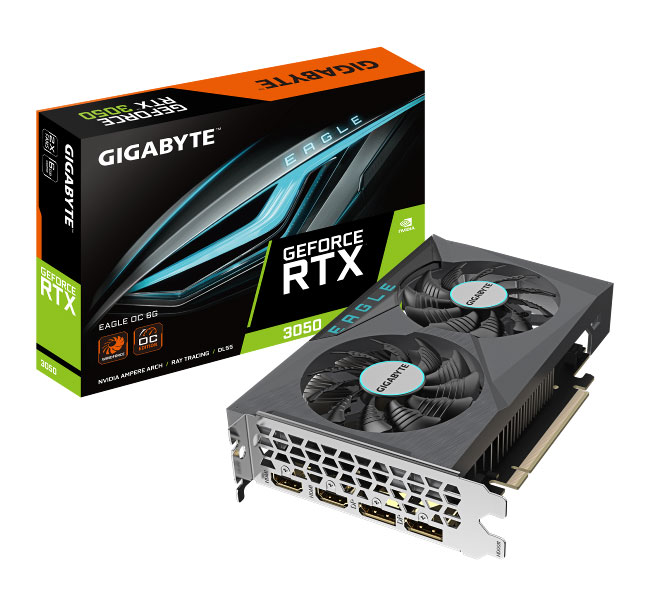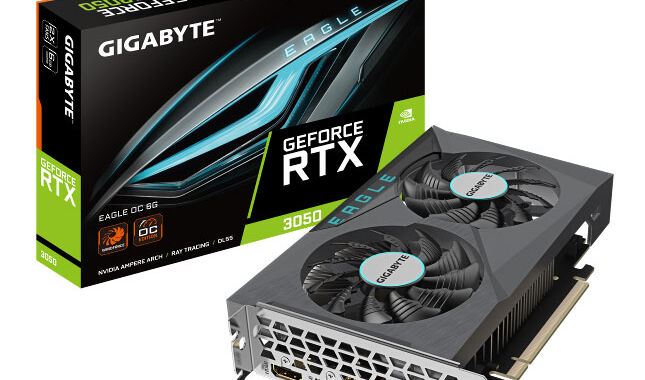New 6GB version of the RTX 3050 may be Nvidia’s first sub-$200 GPU in over 4 years
clearing a low bar —
Exciting? No. New technology? Also no. But it ought to be better than a 1650.

Gigabyte
Nvidia launched three new GPUs last month, part of a Super overhaul of the RTX 40-series designed to improve the value of the company’s $600-and-up graphics cards.
But today, the company is quietly doing something that it hasn’t done in over four years: launching a sub-$200 graphics card. As spotted by TechPowerUp, Nvidia partners like Gigabyte have begun officially announcing a 6GB version of the old RTX 3050 graphics card, albeit with less memory and memory bandwidth, fewer CUDA cores, and lower power requirements.
The announcement follows a few days of leaked retail listings, which generally point to an MSRP of roughly $179 for the new-old card. This would make it Nvidia’s first sub-$200 graphics card launch since the GeForce GTX 1650 Super came out in late 2019, a four-year gap caused partially by a cryptocurrency- and pandemic-fueled GPU shortage that lasted from late 2020 into mid-to-late 2022.
| RTX 3050 6GB | RTX 3050 8GB | GTX 1650 Super | GTX 1650 | RTX 2060 6GB | RTX 3060 12GB | RTX 4060 | |
|---|---|---|---|---|---|---|---|
| CUDA Cores | 2,048 or 2,304? | 2,560 | 1,280 | 896 | 1,920 | 3,584 | 3,072 |
| Boost Clock | 1,470 MHz | 1,777 MHz | 1,725 MHz | 1,665 MHz | 1,680 MHz | 1,777 MHz | 2,460 MHz |
| Memory Bus Width | 96-bit | 128-bit | 128-bit | 128-bit | 128-bit | 192-bit | 128-bit |
| Memory Clock | 1,750 MHz | 1,750 MHz | 1,500 MHz | 2,000 MHz | 1,750 MHz | 1,875 MHz | 2,125MHz |
| Memory size | 6GB GDDR6 | 8GB GDDR6 | 4GB GDDR6 | 4GB GDDR5 | 6GB GDDR6 | 12GB GDDR6 | 8GB GDDR6 |
| TGP | 70 W | 130 W | 100 W | 75 W | 160 W | 170 W | 115 W |
We weren’t in love with the original 8GB version of the 3050—”weird,” “overpriced,” and “could’ve been worse,” we wrote of it during the depths of the GPU shortage in early 2022—and the 6GB version is cut down even further. Its 6GB of memory is attached to a narrow 96-bit memory bus. And while reports differ on exactly how many CUDA cores we can expect—TechPowerUp and Tom’s Hardware say 2,048, while Gigabyte’s 6GB 3050 product pages list 2,304—it’s clear that there are fewer than in the original RTX 3050, and their clock speed is lower to boot.
These specs should make it an OK card for 1080p gaming at medium to high settings, depending on the game. It should also be a decent fit for small-form-factor systems—one of Gigabyte’s versions is a low-profile card suitable for many office desktops—and its 70 W power requirement should mean that the cards can draw all the power they need from the PCI Express slot, without the need for an external power connector.
As a cut-down version of a 2-year-old card based on a 3.5-year-old last-generation GPU architecture, the RTX 3050 isn’t very exciting. But it gets more interesting once you consider that Nvidia’s partners are currently selling the old non-Super version of the GTX 1650 for around the same price. It’s difficult to predict how much the narrower memory bus will impact the 6GB 3050’s performance, but compared to the 1650, it has a significantly higher number of newer CUDA cores, ray-tracing support, another 2GB of RAM, GDDR6 instead of GDDR5, and support for Nvidia’s DLSS upscaling technology (albeit not DLSS Frame Generation, which remains exclusive to the 40-series).
The new card also complicates one of AMD’s selling points for its new Ryzen 8000G processors, which include reasonably capable 1080p integrated GPUs. AMD compared the cost of a $329 Ryzen 7 8700G favorably to the cost of a Core i5 CPU and a GTX 1650 GPU, which deliver similar performance for more money. But the RTX 3050 should decisively outrun the 8700G, and AMD’s pricing argument was already being undercut by the extra expense of socket AM5 motherboards and DDR5 memory.
Nice as it is to see at least some twitch of life in the entry-level GPU market, we’re still a long way from where we were in the mid- to late-2010s, when sub-$200 cards like the GTX 1050 Ti and the 1650 launched not long after the other cards in the same series and used the newest GPU architectures available at the time. There’s a laptop GPU in the RTX 4050 series, but a desktop version looks highly unlikely at this point—to say nothing of a desktop version at or under $200. But a belated, uninspiring improvement is an improvement nonetheless.
New 6GB version of the RTX 3050 may be Nvidia’s first sub-$200 GPU in over 4 years Read More »
